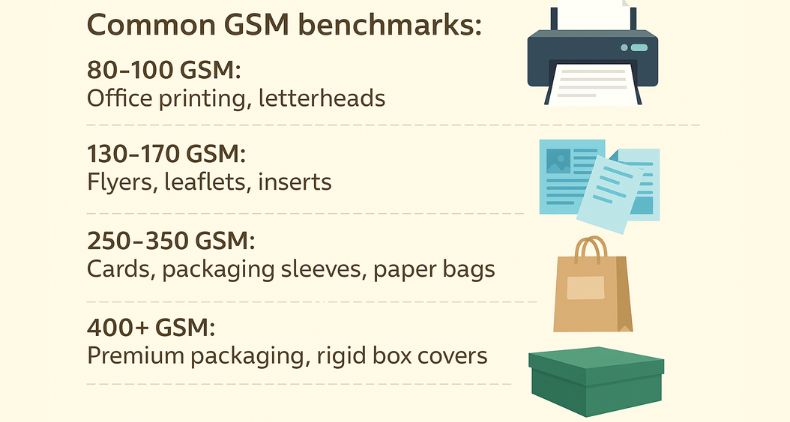If you’ve ever placed orders for prints or special packaging, chances are you’ve heard both terms paper weight and paper thickness. They sound similar enough — close to being interchangeable, one might even say — but they’re not quite synonymous.
We’re often asked questions like, “I’ve ordered 300 GSM paper, so it must be thick, correct?” Nope.
Let’s break down each term, how it’s measured, and why it matters when you’re printing everything from flyers to rigid boxes.

Table of Contents
ToggleWhat Is Paper Weight?
Paper weight refers to exactly how heavy a sheet of paper is. It’s most commonly measured in GSM (Grams per Square Meter).
- GSM (metric): Measures exactly how much 1 square meter of paper weighs.
- Higher GSM = heavier paper = typically thicker, but not necessarily.
Standard GSM standards:
- 80–100 GSM: Office stationery, letterheads
- 130–170 GSM: Leaflets, flyers, inserts
- 250–350 GSM: Paper bags, packaging sleeves, cards
- 400+ GSM: Premium packaging, rigid box covers
Think of GSM as a weight category. Two papers can weigh identically but feel very different based on texture and coating.
What Is Paper Thickness?
Paper thickness is the physical measurement of exactly how thick the paper is. It’s usually measured as being in microns (µm) or millimeters (mm).
- 1 micron = 0.001 millimeter
- A normal 300 GSM coated paper might be ~270 microns, and an uncoated 300 GSM paper might be ~360 microns
Thickness is also called “caliper” in the printing world, and it’s what you feel when you squeeze the paper between your fingers.

Paper Weight vs Paper Thickness: What's the Difference?
| Property | Paper Weight | Paper Thickness |
|---|---|---|
| What it measures | Mass per area (GSM) | Physical thickness (microns/mm) |
| Measurement unit | Grams per square meter | Microns (µm) or millimeters |
| Affects | How heavy/dense the sheet feels | How bulky the sheet feels |
| Influenced by | Composition, coating | Fiber structure, surface treatment |
| Why it matters | Postage, pricing, sturdiness | Folding, binding, stacking |
A Case Study from Veesham
We once printed two sets of invitation cards — both on 300 GSM paper. One was an art coated paper, and the other a textured cotton paper.
Though both had the same GSM:
- The cotton paper had a thicker, more premium, rougher hand-feel.
- The art paper had a finer but lighter feel, and color printed richer.
That’s because the cotton paper had more air between fibers, increasing its caliper (thickness), while the art paper was compressed and coated, making it denser but slimmer.
When to Consider Thickness Over Weight (And Vice Versa)
Here’s how to decide what’s more important:
Choose based on weight (GSM) if:
- You’re quoting pricing or calculating shipping
- You need to match previous print jobs
- You want to stay within budget but still feel premium
Choose based on thickness if:
Packaging Tip
Two 300 GSM papers can perform very differently. For example:
- 300 GSM textured kraft = more bulk, more thickness, rustic look
- 300 GSM glossy art paper = less thickness, sleeker finish, better for high-res images
Consider thickness first if you’re producing packaging that needs to keep its shape. If you’re looking for a tidy, coated finish, prioritize GSM and finish.
Here at Veesham, we support customers’ hand-testing samples because what looks good on paper (literally) doesn’t always translate to the real world.
Let's Test Your Samples
If you’re testing your samples against each other:
- Rest both pieces flat — thicker paper will be less likely to bend
- Fold them — thicker paper can crack or be resistant to sharp folding
- Rub the surface — coated papers will feel smoother, uncoated papers feel fibrous
Still unsure? Ask for a dummy. We’re happy to mock up samples before you go to final print.
Your Takeaway
Whether you’re printing a brochure, rolling out product labels, or printing a corporate brochure, understanding paper thickness vs. weight is an advantage.
At Veesham, we don’t just ask “how many grams?” We ask: How do you want it to feel? For whom? Will it fold? Will it ship?
Using that as our guide, we help you select not only the ideal paper but also the appropriate one.
